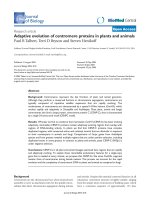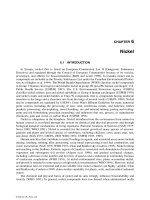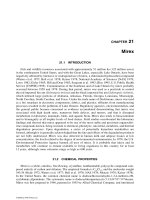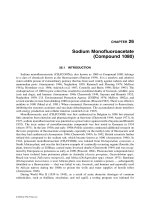3 3 where plants and animals live (life science)
Bạn đang xem bản rút gọn của tài liệu. Xem và tải ngay bản đầy đủ của tài liệu tại đây (3.35 MB, 14 trang )
Life Science
by Bobbie Nyden
Genre
Nonfiction
Comprehension Skill
Text Features
Main Idea and Details • Captions
• Labels
• Glossary
Science Content
Ecosystems
Scott Foresman Science 3.3
ISBN 0-328-13814-2
ì<(sk$m)=bdibec< +^-Ä-U-Ä-U
Vocabulary
What did you learn?
community
1.
desert
2.
ecosystem
environment
Bobbie
Nyden
3. Which kinds by
of forests
have
trees that drop their
leaves?
grassland
4.
In this book you have
read about what happens to coyote populations
when it rains a lot in Southern California. Write
to explain why there could be more coyotes when
it rains, using what you have read.
5.
Main Idea and Details What main
idea did you learn about the tundra? What other
details did you learn about the tundra?
population
tundra
wetland
Photographs: Every effort has been made to secure permission and provide appropriate credit for
photographic material. The publisher deeply regrets any omission and pledges to correct errors called to its
attention in subsequent editions. Unless otherwise acknowledged, all photographs are the property of Scott
Foresman, a division of Pearson Education. Photo locators denoted as follows: Top (T), Center (C), Bottom
(B), Left (L), Right (R) Background (Bkgd)
Title Page: ©The Image Bank/Getty Images; 6 ©DK Images 8 (Bkgd) ©George Grall/NGS Image
Collection, (BR) ©Danny Lehman/Corbis; 9 ©Robert Pickett/Corbis; 12 (T, CL) ©DK Images, (BL) ©Breck
P. Kent/Animals Animals/Earth Scenes; 13 (TR) ©Carolina Biological Supply Company/Phototake, (BR)
©Randy M. Ury/Corbis; 14 ©Frans Lanting/Minden Pictures; 15 (TR) ©Kevin Schafer/Corbis, (CR) ©Gary
W. Carter/Corbis, (BR) ©DK Images; 16 (CL) ©Rolf Kopfle/Bruce Coleman Inc., (CR) ©Michael Quinton/
Minden Pictures, (BR) ©The Image Bank/Getty Images; 17 (T) ©Suzanne L. & Joseph T. Collins/Photo
Researchers, Inc., (BL) ©Tim Laman/NGS Image Collection, (BL) ©E. R. Degginger/Bruce Coleman Inc.;
18 ©Jeff L. Lepore/Photo Researchers, Inc.; 19 ©Gerry Ellis/Minden Pictures; 21 ©James L. Amos/Photo
Researchers, Inc.
ISBN: 0-328-13814-2
Copyright © Pearson Education, Inc.
All Rights Reserved. Printed in the United States of America. This publication is
protected by Copyright and permission should be obtained from the publisher prior
to any prohibited reproduction, storage in a retrieval system, or transmission in any
form by any means, electronic, mechanical, photocopying, recording, or likewise. For
information regarding permissions, write to: Permissions Department, Scott Foresman,
1900 East Lake Avenue, Glenview, Illinois 60025.
3 4 5 6 7 8 9 10 V010 13 12 11 10 09 08 07 06 05
Where Plants and
What do animals need from their habitat?
Animals Live
How do the plants in the grassland get water?
What are ecosystems?
Places for Living Things
A living thing needs just the right environment. An
environment is everything around a living thing.
Plants and animals are living things. They need
Climate is also important for an environment.
Climate is the weather a place has over many years.
Different environments have different climates.
Climate affects an environment’s water and soil.
Water and soil affect the plants in an environment.
Plants need certain kinds of water and soil to live.
sunlight, water, and soil. They also need the right kind
of weather. Sunshine warms the environment. It helps
plants make their own food.
2
3
Parts of an Ecosystem
Plants and animals get what they need from where
Special Homes
Plants and animals both need a place to live. This
they live. They interact with nonliving things in an
place is their habitat. They get what they need from
ecosystem. The parts of an ecosystem work together.
their habitat. Plants get light, air, water, pollinators,
Redwood trees grow in a coastal
ecosystem. Rain and fog from
the ocean give them water.
The parts of this
ecosystem need each
other. Some birds
and space to grow. Animals get food, water, and a
space to live and grow.
If a part of a habitat is missing, the plants and
animals can’t live there. They might not get what
they need to live. They might have to move to a
new place.
find fish to eat in the
ocean. Then they fly
to the redwood trees
to make nests.
These trees are part of
a coastal ecosystem.
Dune grass grows in
a habitat with sand.
4
5
Groups Within Ecosystems
Living things of one kind that live in the same
place at the same time are a population. Southern
California has many coyote populations. They live on
brushy hillsides.
Squirrels live on the hillsides too. Coyotes hunt
Ecosystems Change
Sometimes ecosystems change. First, one part of the
ecosystem changes. This causes other parts to change.
If it rains a lot in Southern California, plants will
grow more. Squirrels have more
food to eat. The squirrel
the squirrels. The coyotes, squirrels, and other living
population increases.
things in the ecosystem make up a community.
More squirrels mean
more food for coyotes.
The coyote population
increases too.
Squirrels and coyotes are part of the
community in this hillside ecosystem.
These two coyotes are
part of a population.
6
7
Grassland plants have long roots. They can get
Which ecosystems have
few trees?
water that soaks deep into the soil. Winter frost kills
Grassland
grow from the roots.
Some places on Earth are warmer than other places.
plant leaves. Roots store food to grow new leaves in
spring. Grazing and fire kill leaves too. New leaves
Some grasslands get more rain than others. Tall
These places have less rain and fewer trees. Such
grasses grow there. Short grasses grow where there is
places are called grasslands.
less rainfall.
A grassland is a land ecosystem. It has many
grasses and plants with flowers. Grasslands have cool
or cold winters and hot summers. The summers are
often dry. Grassland soil is also dry. It is too dry for
trees to grow there.
8
How much rain do you think this grassland gets?
9
Desert—A Surprising Ecosystem
A desert is a place that gets little rain. During the
day, it is usually very hot. At night it is cool or even
cold. Plants and animals that don’t need much rain
live there. Cactus plants can live in the desert. They
Many desert animals hide during the hot day. Some
stay in tunnels under the ground. Others rest under
plants. Desert animals go looking for food at night,
when it’s cool. Snakes find and eat small animals.
Bobcats hunt for birds and small animals to eat.
store water in their stems.
Desert bobcat
This desert is very dry.
Sidewinder
rattlesnake
10
11
Tundra—Land of Long Winters
Trees can’t grow in the tundra. Their roots can’t
The tundra is a place that is very cold and dry. It is
near the North Pole. Tundra winters are long and cold.
Tundra summers are short and cool. Tundra soil stays
frozen underground all year.
grow in the frozen soil. Small plants, such as grasses
and wildflowers, can grow there.
The snow melts during the tundra summer. It
forms ponds. Birds make nests near the ponds. In the
summer they find insects to eat. Most tundra birds fly
Summer days in the tundra are very
to warmer places in the winter.
long. The Sun shines twenty-four
hours a day on some parts of the
tundra during summer. Winter
Why can’t trees grow
in the tundra?
days in the tundra are very short.
In some places, the Sun doesn’t
shine at all in the winter.
A group of wolves
is called a pack.
Wolves hunt in the
tundra in packs.
A group of caribou is called
a herd. The herd stays
together in the tundra.
12
13
What are some
forest ecosystems?
Coniferous and Deciduous Forests
Coniferous forests grow where the winters are cold
Deciduous forests grow where there are rainy
summers and snowy winters. Oak and maple trees
are deciduous. Deciduous trees drop their leaves in
the fall.
More sunlight reaches down through deciduous
forests. That allows plants to grow. Many animals
and snowy. Coniferous trees have leaves like needles.
can live in a deciduous forest. Insects and birds live
Spruce and pine trees are coniferous trees.
in the plants and trees.
Most plants can’t grow under conifer trees. Some
animals can live under conifer trees. They can find
food and shelter in the coniferous forest.
North American coniferous forest
14
North American deciduous forest
15
Tropical Forests
Tropical forests grow where it is warm all the time.
These forests get lots of rain. Many tall trees grow in
tropical forests. Little sunlight reaches the gound in
tropical forests. Many plants grow on the tall trees so
they can get sunlight. Most of the animals live in the
trees too.
Birds and insects live in tropical forests. There are
many different tropical forest insects. There are so
many that we haven’t named them all!
Tropical forests are full of amazing animals. One
tropical forest in Brazil has beetles that don’t live
anywhere else. Some tropical forest spiders are big
enough to eat birds!
These animals live
in tropical forests.
Tropical forests
are home to lots
of animals.
Rainbow
lorikeet
Red stinkbugs
16
17
What are water ecosystems?
The water is there most of the year. But it is not very
Freshwater Ecosystems
deep. Trees, grasses, and plants live in a wetland.
Places that have fresh water include lakes, ponds,
rivers, and streams. Lakes and ponds have land all
A wetland is low land that is covered with water.
Some of the animals that live there are fish, bears,
and birds.
around them. In rivers and streams the water moves.
Some of these places get fresh water from under
the ground. Other places get water from rain or
snow. Many plants and animals live in places with
fresh water.
Alligator
These animals
live in wetlands.
Manatees eat the
plants that grow
there. Alligators eat
the fish and birds
that live there.
Manatee
18
19
Saltwater Ecosystems
Many rivers flow into the ocean. Fresh river water
Oceans contain salt water. Oceans are shallow near
the land. Clams, crabs, and fish all live near the shore.
The water gets deeper as you move away from land.
Fish, shrimp, and whales live in deeper water. Water
far below the surface is dark and cold. No plants and
few animals can live there.
mixes with salty ocean water. When this happens, a
salt marsh can form.
A salt marsh is a kind of wetland. Special plants
and animals live in a salt marsh. They can live in
water and soil that has salt. Many fish, crabs, and
other animals are born in salt marshes.
Do you think these
animals are found
in deep or shallow
water?
Cuttlefish
Coral reef
20
21
Our Earth has many different ecosystems.
Ecosystems give us and other living things
Ecosystems are always changing. Ecosystems change
everything needed to live! Without ecosystems,
when the climate changes. They change when
there could not be life.
animals move out of them or into them. They
change in many ways.
22
23
Glossary
Vocabulary
What did you learn?
community
community
all of the different groups of living
1. What do animals need from their habitat?
desert
things found in one place
2. How do the plants in the grassland get water?
desert
ecosystem
a place that gets very little water
ecosystem
all of the living and nonliving things
environment
grassland
environment
population
interacting in an environment
In this book you have
read about what happens to coyote populations
when it rains a lot in Southern California. Write
to explain why there could be more coyotes when
it rains, using what you have read.
5.
Main Idea and Details What main
idea did you learn about the tundra? What other
details did you learn about the tundra?
thing
a place with lots of grasses and
wetland
few trees
population
living things of the same kind living
in one place
tundra
a flat,
place
that
is very
Photographs: Every effort has been
made totreeless
secure permission
and provide
appropriate
creditcold
for
photographic material. The publisher deeply regrets any omission and pledges to correct errors called to its
attention in subsequent editions. Unless otherwise acknowledged, all photographs are the property of Scott
Foresman, a division of Pearson Education. Photo locators denoted as follows: Top (T), Center (C), Bottom
(B), Left (L), Right (R) Background (Bkgd)
Title Page: ©The Image Bank/Getty Images; 6 ©DK Images 8 (Bkgd) ©George Grall/NGS Image
Collection, (BR) ©Danny Lehman/Corbis; 9 ©Robert Pickett/Corbis; 12 (T, CL) ©DK Images, (BL) ©Breck
P. Kent/Animals Animals/Earth Scenes; 13 (TR) ©Carolina Biological Supply Company/Phototake, (BR)
©Randy M. Ury/Corbis; 14 ©Frans Lanting/Minden Pictures; 15 (TR) ©Kevin Schafer/Corbis, (CR) ©Gary
W. Carter/Corbis, (BR) ©DK Images; 16 (CL) ©Rolf Kopfle/Bruce Coleman Inc., (CR) ©Michael Quinton/
Minden Pictures, (BR) ©The Image Bank/Getty Images; 17 (T) ©Suzanne L. & Joseph T. Collins/Photo
Researchers, Inc., (BL) ©Tim Laman/NGS Image Collection, (BL) ©E. R. Degginger/Bruce Coleman Inc.;
18 ©Jeff L. Lepore/Photo Researchers, Inc.; 19 ©Gerry Ellis/Minden Pictures; 21 ©James L. Amos/Photo
Researchers, Inc.
and dry
a place that is covered in shallow
water for most of the year
ISBN: 0-328-13814-2
Copyright © Pearson Education, Inc.
All Rights Reserved. Printed in the United States of America. This publication is
protected by Copyright and permission should be obtained from the publisher prior
to any prohibited reproduction, storage in a retrieval system, or transmission in any
form by any means, electronic, mechanical, photocopying, recording, or likewise. For
information regarding permissions, write to: Permissions Department, Scott Foresman,
1900 East Lake Avenue, Glenview, Illinois 60025.
3 4 5 6 7 8 9 10 V010 13 12 11 10 09 08 07 06 05
24
4.
everything surrounding a living
tundra
grassland
wetland
3. Which kinds of forests have trees that drop their
leaves?









